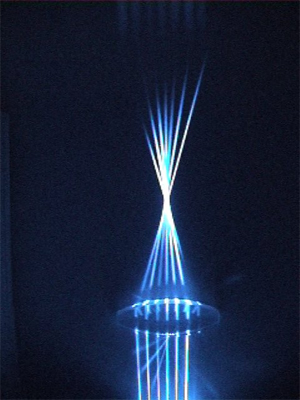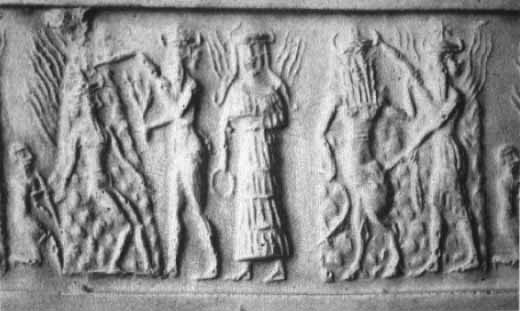the Vedas, Greece, Sumer and meso-america
PART V
BD 17 is almost ready; it is very extensive, with difficult themes,
but appears to deal with the pic(to right) as the cherub ring
having been altered, now projecting RÃ, as this sun, at the point
of convergence of the blue lines. We have often said that hieroglyphs
(or any old text, for that matter) can difficultly be read when
the intended concept they convey is lacking to us; but the type of
concept is so vital for the text, that when we think we found another one,
we need to falsify that over and over again – also against other
ancient texts, hence this part V – continuing upon the bas-relief
of inversion in Tutãnkhámen’s tomb (see log;
pictures will be added again at end of this page).
Sun Gods
…we know that Rã was created from the binary, below. We know he ‘ascended’,
as his very name shows, we know his character is
“willpower (eden’s!)/of speech (matrix)”,
also as his name; that he “burns-up and radiates”
the imprisoned word of the Watercourse,
and that he must have taken the task which was of the cherub-wheel,
which is ‘speech-related’, as well. The area as upper-node
(just above the cube, as ‘the head’) is complex,
containing several themes in every text; we will try to make
the differences as congruent as possible;
Sumer [1]
Śamaś or Utu was a lesser (later) deity; not because he was not
important but because, like Rã, he was created when they started
this present solarsystem – that is why he originates from Nannar,
the moon (not his present moon). [2]
- šamšu
ud [sun] wr. ud “day; heat; a fever;
summer; sun” Akk. immu; ummedu; umšu; šamšu; ūmu - šamru
sumur [angry] wr. sumur;
sumurx(KA) “(to be) angry, furious” Akk. ezzu; šamru - šamû
an [sky] wr. an “sky, heaven; upper;
crown (of a tree)” Akk. šamû
gira [concealment] wr. gira “concealment; sky, heaven”
Akk. puzru; šamû un [high] wr. un3 “to arise; sky;
(to be) high” Akk. elû; šamû; šaqû
utah [heaven] wr. utah “heaven” Akk. šamû
zigara [heavens] wr. zigara “the heavens” Akk. šamû [3]
the sun and Ba spirit-souls
What we are looking for, is the relation between Rã and the Ba-souls,
since these former ‘dead bodies’ were revitalized through the type
light of this sun – both of them “being a mixture” of solarplane aspects
and eden’s light. We saw the Ba-soul in the murals sitting atop of the castle,
and pictured within the middle-disk in Tutankhamen’s golden basrelief;
where in the spells they are continuously linked with the place of Õn,
as the fortress below Rã. Therefore the link to Akkadian, and from there to
old hebrew is important for us, since several themes keep returning by this sun-god,
especially ‘veil’ and ‘darkness’ and ‘mixture’. In the next part VI we will see
how there were four type curtains places as roof over the exodus Tabernacle,
of which the second (from inside) was “of goat-hair”; and that same theme returns
in the book of Revelation, where “the sun gets black as goat-hair”. The Tabernacle
can be understood as ‘the area of the head’ (upper node), but until now enshrouded
within the goat-hair veil being Rã; the ‘hair’ from H168, “tent” (therefore
related to the upcoming festival of booths), and the ‘goat’ from H166, “strong”,
goat AZ from AZAZ, ‘strong’. The latter is derived from
Akkadian EZZU in above cluster, “furious, angry, reddish, ruddy”;
where the reddishness is pointing to the reddishness of
glyph T’ESHER, mutilated-eden-aether; and the “furious”
to the very nature of the Ba-spirit-souls.
The ‘furious’ as Akkadian EZZU, is also the root of the fallen angel Azazel,
the goat; according to the book of Henoch, Azazel was the leader of the angels
‘who took themselves women’, which is again showing the aspect of mixture; he was
sentenced to be thrown down into Dudãel, ‘the cauldron’, which we know now as the
glyph AB or ABT’U; where the AB-cluster typically represents “mixture”, as the realm-
and physical garments; it’s main glyphs as “spotted, variegated, leopard, Ba-soul,
and Abbait (abaddon)”, suggesting very strongly that Azazel is another description of
the same nature as Abaddon-apollo in the book of Revelations. We needed to show
the relation, because in the Vedas this very theme will return;
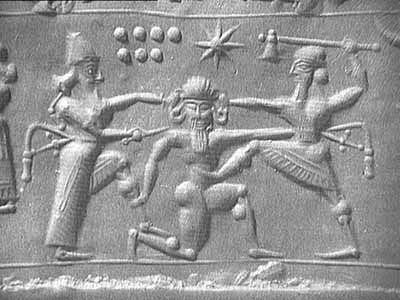
slaying Humbaba
the deity Gilgamesh, together with Lugulbanda, defeated the monster Humbaba,
who was the guardian of the cedar forest, where the gods lived, and hew down
the cedar of life. The Akkadian epics (having roots in Sumer) tend to slightly
mix-up events and concepts, which happens in most derived religions from a same
ancestor root, but the overall themes are recognizable still:
- Gilgamesh, the hero, probably from BIL.GA.MESH, containing
“ancestor” and “young man”, together with the star-symbol which represents
a deity; the very context of the personage links him to Ba-soul;
it is likely he is another mask of sumerian Enki (Azazel),
who got locked into the Abzu, as again the same cauldron. see [4]. - making his partner, with whom he travels to Humbaba, the represent of the
Ba-souls, themsélves: Enkidu as “the creation of Enki”,
formed from clay and saliva by Aruru; where Aruru is the
same as Ninhursag, “lady of the mountain” as the
house of Saturn (the construct); and the ‘saliva’ is then obviously
the stolen essence of the mouth (tile) as redness;

Enki in the dimensional doorway of the Abzu [4]
HU.PI.PI. huwawa [monster] wr. hu-wa-wa “figurine (of face) of ~;
a mythological monster” [5]
|
‘His face is that of a lion. “When he looks at someone, it is the look of death.” “Humbaba’s roar is a flood, his mouth is death and his breath is fire! He can hear a hundred leagues away any [rustling?] in his forest! Who would go down into his forest!” In various examples, his face is scribed in a single coiling line like that of the coiled entrails of men and beasts, from which omens might be read.’ [6]
The main theme about Humbaba is “the head” (upper node); the lion being “ultimate rule”, and the ‘look’ is related to Sight, just as in the spells, as the sight derived from speech; the ‘mouth’ is the tile and the ‘breath’ is the word of the Watercourse. However the ‘single coiling line’ is unclear – but may relate to the nested regions (‘shrines’); |
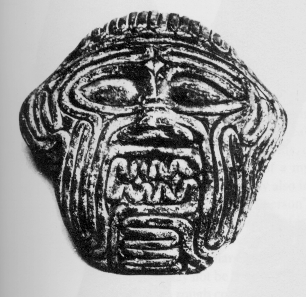 |
by offering his sisters as wife and concubine. When Humbaba’s guard is down,
Gilgamesh punches him and captures the monster. Defeated, Humbaba appeals
to a receptive Gilgamesh for mercy, but Enkidu convinces Gilgamesh
to slay Humbaba. In a last effort, Humbaba tries to escape but is
decapitated by Enkidu, or in some versions by both heroes together;
his head is put in a leather sack, which is brought to Enlil,
the god who set Humbaba as the forest’s guardian. Enlil becomes
enraged upon learning this and redistributes Humbaba’s seven splendors
(or in some tablets “auras”). “He gave Humbaba’s first aura to the fields.
He gave his second aura to the rivers. He gave his third aura to the reed-beds.
He gave his fourth aura to the lions. He gave his fifth aura to the
palace (one text has debt slaves). He gave his sixth aura to the forests
(one text has the hills). He gave his seventh aura to Nungal.”
No vengeance was laid upon the heroes, though Enlil says,
“He should have eaten the bread that you eat,
and should have drunk the water that you drink!
He should have been honored.”
in exchange, from Humbaba. The seven gifts successively given by Gilgamesh were:
(a gap in the text),
eca-flour,
big shoes,
tiny shoes,
semi-precious stones, and
a bundle of tree-branches.
the fifty unmarried young men he has brought on the adventure are
felling cedar timber, stripping it of its branches and laying it
“in many piles on the hillside,” ready to be taken away. [7]
- the seven ‘radiances’ should be the seven ÁAT-regions,
who are transformed into ‘seven cows’ as new regions above the tile;
these doubled ÁAT’s should be “Gilgamesh’ sisters”; - the “leather bag” returns in many texts, and is immediately related
to the veil of goat-hair, previously; context suggests it contains
the area just upon the eden tile as place of eden’s light — now
being covered as bag, brought to Enlil - the concept of Enlil
must be “the rule of the main mountain” (see diagram),
The re-distributing themes show again a doubling, and causes us
to look again at the nature of cows, the áats and ákhem-stars,
- the first aura to “the fields”, perhaps of the island of the horizon,
- the second to “the rivers”, those crossing the fields (see vignette BD 110)?,
- the third to the reed-beds, as the Seket Áaru fields,
- the fourth to the lions – we know of ‘lion-mouth’, but as multiple-place unclear,
- the fifth to the palace, likely of Õn; that the other version has ‘debt slaves’
may pertain to the same place having adamite originals, held within the fortress [SNB], - the forests – perhaps the sh-pool south, within lampstand; remember
the ‘exchange of trees, brought and taken by the monkeys’ in Ramayana, - the seventh to Nungal; as “goddess of the underworld” she just may be
‘the land, south’, now again enlightened by the mutilated-light of Rã;
this Nungal has a husband compared to Nergal [the Sekhemt-lion of Rev.5],
and the latter is also the official husband of Ereshkigal, the main goddess
of the underworld. In other versions the husband of Ereshkigal is the bull
Gugulanna (see next paragraph), and both versions make absolute Sense.
In the text below, Ereshkigal must represent ‘the lampstand’ as the eden rule
over the land south,
The ‘seven gifts of Gilgamesh’ are less clear –
- the “big shoes” and “little shoes” could be ‘the binary, below’
and ‘this solarplane’; we think the glyph THEBT- as “sandal”
may relate to “this solarplane (as the foot-glyph B) may like
‘stand upon’ the binary, below; the size perhaps
related to “dimensional size”. - the ‘semi precious stones’ perhaps are “a mixture-type energies”,
as HRU, mutilated eden light; - the “little sister” is obscure: by some said to translate as
“little fig” or “vagina”, but are too vague, as the other two,
to can interpret;
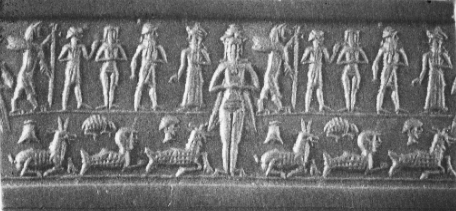
link is below [9]
b] The descent of Innana
Inanna represents “the entire construct they built over eden”,
but in this Descent story, the construct still is in need of
eden’s aspects; hence through seven gates she arrives in the
underworld, being the same theme as presented in Gilgamesh –
we are sorry we cannot always locate the used names and terms
[since thóse often hold major clues], perhaps later,
when having more time;
on the door of the underworld. She shouted aggressively at the gate of
the underworld: “Open up, doorman, open up. Open up, Neti, open up.
I am all alone and I want to come in.”
— the “door” of the underworld, read of the land south,
must be the tile, in spells often as “double great door”;
Ganzer we’ve found as GAN.SEsar, “a plant”, where in previous line
Enki tells her ‘to find the plant of life’ (but perhaps Ganzer
is a composite term);
underworld, answered holy Inana: “Who are you?” “I am Inana
going to the east.” “If you are Inana going to the east, why
have you travelled to the land of no return? How did you set your
heart on the road whose traveller never returns?” [8]
— the “east” indicates heaven, where Henoch describes
“the East being the face of Heaven”, and we saw how the same term
“\\the east” is used in the spells; then it makes sense that the doorkeeper
tells it is a dangerous road,
“Because lord Gud-gal-ana, the husband of my elder sister holy
Erec-ki-gala, has died; in order to have his funeral rites observed,
she offers generous libations at his wake —
that is the reason.”
— though written here Gud-, it is the same bull-cherub from
the eden-land, below [as Eresh-ki-gal]; note how “he has died”,
and how the land south is offering libations: read,
Inanna comes down to steal them;
Erec-ki-gala slapped the side of her thigh. She bit her
lip and took the words to heart. She said to Neti,
her chief doorman: “Come Neti, my chief doorman of the underworld,
don’t neglect the instructions I will give you. Let the
seven gates of the underworld be bolted. Then let each door
of the palace Ganzer be opened separately. As for her,
after she has entered, and crouched down and had her
clothes removed, they will be carried away.”
— the “seven gates” appear much like the (glyph) ÃRIT’s,
as the same concept as the bridge the monkeys built in Ramayana;
the goal is that Inana is stripped from her garments and jewels,
open country, was removed from her head. “What is this?”
“Be satisfied, Inana, a divine power of the underworld has been
fulfilled. Inana, you must not open your mouth against the
rites of the underworld.”
— in the next verses, the entire line is repeated
[which we will skip], but the “nót open the mouth” is particularly
strange to us – since that was their entire goal, to ópen the mouth;
the “turban” as crown is the region of the head, just above the tile,
or perhaps better “the covering óf that area”; in a previous line
“she took a wig for her forehead”, the wig being the curls of
Hathor, representing covering,
beads were removed from her neck. [etc]
— the lights of lapis-lazuli as glyph KHESBT’,
apparently related to the necklace as Anubis wears (diagram),
which may depict the concepts within the area of the head
[compare the coil at Humbaba],
beads were removed from her breast. [etc]
— the breasts always as the double-gate SBA, see diagram;
in a previous line, “she hung the beads around her neck”,
which makes contextually more sense –
because the throat-glyph is about the double-Sba-gate;
here definitely must be a connection with the breastplate of
the highpriest, where next to twelve jewels were
also placed two onyx stones, see next,
the “Come, man, come” pectoral was removed from her breast.
— when guessing anyway, the man may be “masculine” here,
the masculine as glyph THA which they desire,
but the line is too unclear to can see what is meant here,
the golden ring was removed from her hand.
— the ‘hand’ as executive region;
the ‘ring’ should be the cherub-wheel, in context;
that it is “gold” must imply eden’s words which they wanted
so much, turned to (glyph) NUB-;
compare also the book of Haggai,
“I will place you as a seal-ring around my finger”,
in similar context,
and measuring line were removed from her hand.
— as reference to the Q-axis south,
removed from the executive region as ‘hand’,
was removed from her body.
— we can’t find any pala, but PA.PA.AL, ‘bud’;
the “bud” is the expression of the lampstand itself
[see Is.18 page, and others],
perhaps it’s a stretch – but the bud holds Eden’s feminine,
and may relate to ‘ladyship’; it is a better context as
for example PE.EL.LA, “to defile, thin, light”,
they were carried away. Then she made her sister Erec-ki-gala
rise from her throne, and instead she sat on her throne.
The Anuna, the seven judges, rendered their decision against her.
They looked at her — it was the look of death.
They spoke to her — it was the speech of anger.
They shouted at her — it was the shout of heavy guilt.
The afflicted woman was turned into a corpse.
And the corpse was hung on a hook.
— difficult to follow the story, now;
the represent of the M-realm, north, comes down all the way
into the lampstand, yet ends up dead; the parallel could be
“the dead bodies” KHAT- here, as the offspring of the fallen
ones; because the story’s goal is “to let Inanna rise up again”.
Inanna is a construct however, therefore she must represent
“the KH-house”, itself (see Ninshubur below). Inanna now
‘sits on the throne’ (in the centre of the lampstand),
but is ‘killed’ – likely as the pre-deluge world (10,000-8000 BC);
yet is to rise later on as new solarplane and Sekhet-fields.
Perhaps the term Anunna was intended having a different context,
because the line makes no sense; and the ‘hook’ we can only
find as ŚA, ‘hook (?)’, but apparetly that cluster is
about “grain”;
considering all we know, so far, the “hook” may be very well
the old-hebrew Vav, as part of the name EIUE, where the Vav
is ‘the word’ as vowel-U; hence the hook is either
“the Watercourse” or the “place-T-e as the half-staff
[within lampstand]”, or a combination of both.
her minister Nincubura carried out the instructions of
her mistress. She made a lament for her in her ruined
(houses). She beat the drum for her in the sanctuaries.
She made the rounds of the houses of the gods for her.
She lacerated her eyes for her, she lacerated her nose. In
private she lacerated her buttocks for her. Like a pauper,
she clothed herself in a single garment, and all alone she
set her foot in the E-kur, the house of Enlil. Enlil, she
lamented before Enlil: “Father Enlil, don’t let anyone kill
your daughter in the underworld. Don’t let your precious metal
be alloyed there with the dirt of the underworld. Don’t let your
precious lapis lazuli be split there with the mason’s stone.
Don’t let your boxwood be chopped up there with the carpenter’s
wood. Don’t let young lady Inana be killed in the underworld.”
— Where Inanna was the KH-house, Ninshubur must be “the dead
body as spirit”; several themes return here, related to the Ba
spirit-soul, as the “lamenting” [the tears,glyph REM, as the essence
by which fish-souls are made]; the “beating of the drum”, as the
solarplane causing (physical) rhythms; the ’rounds’ perhaps as
“revolving dimension”, PKHR, and the ‘lacerating’ likely as “engraving”,
glyph PTH’ – where buttocks is “the dimensional backside of
eden’s root”.
She laments before Enlil [the mountain north, where she is right now]
to not let the precious “metal”, glyph BAÁ, as the iron type-energy of
the solarplane to be polluted; the “lapis lazuli” as the blue-energy
KHSBT, to be “split by (the axis of eden’s) tile”; and the two types
of wood as the different trees described in Isaiah.
What has the hierodule of An done? She has me worried.” He removed
some dirt from the tip of his fingernail and created the kur-jara.
He removed some dirt from the tip of his other fingernail and created
the gala-tura. To the kur-jara he gave the life-giving plant. To the
gala-tura he gave the life-giving water.
— that he is busy with a ‘finger’ sounds like the glyph ÃNT-, “claw,finger”,
into lampstand; the ‘nail’ must relate to “ivory”, glyph AB-
(compare the paragraph above), and by extension then both
creatures must be either both shoulders of the lampstand, or both axis
[k- and inversed-q]; but since a next verse addresses “sceptres”,
likely those are the axis – and here the theme is the shoulders.
The term “gala-tura” can come from “great” and a possible “date palm
offshoot” TUR; the kur-jara perhaps as “mountain [or light] KUR”,
where IR- can be “ẗype of tree + to plunder”, to the gala-tura he gave
the “lifegiving water” (as imprisoned word of the deflected watercourse..?),
and to the kur-jara the “lifegiving plant”, perhaps as ÁMM-tree;
|
[226-235] Then father Enki spoke out to the gala-tura and the kur-jara: ” (1 ms. has instead the line: One of you sprinkle the life-giving plant over her, and the other the life-giving water.) Go and direct your steps to the underworld. Flit past the door like flies. Slip through the door pivots like phantoms. The mother who gave birth, Erec-ki-gala, on account of her children, is lying there. Her holy shoulders are not covered by a linen cloth. Her breasts are not full like a cagan vessel. Her nails are like a pickaxe (?) upon her. The hair on her head is bunched up as if it were leeks.
|
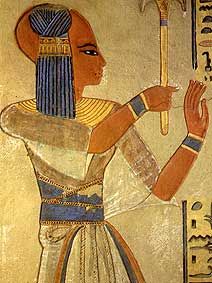 |
— the ‘life-giving’ is undoubtedly ãnkh-life;
that “her shoulders are uncovered” should relate to both outer-arms
of the lampstand, as glyph-REMEN; we cannot locate the word ‘cagan’
except for ŚA3.GAN, ‘perfect’; the Akkadian term gitmalu renders the
same but has also ‘foremost’ and ‘snake’, altogether suggesting that
both SBA-gates are vacant, at this moment.
| The leek [to right] is a somewhat strange comparison, suggesting that “the covering of the head as eden’s place” has been inverted – now covering the Sekhet fields…? Compare how the egyptians were obsessed with the “side lock”, as a tuft of hair from the side of the head – also this moon KHENSU wears one – and the ‘side’ could relate to ‘dimensional side’, in this case ‘to their side’, ofcourse. | 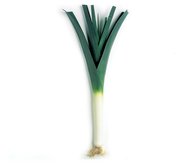 |
them sprinkled on it the life-giving plant and the other the
life-giving water. And thus Inana arose. So when Inana left the
underworld, the one in front of her, though not a minister, held a
sceptre in his hand; the one behind her, though not an escort, carried
a mace at his hip, while the small demons, like a reed enclosure,
and the big demons, like the reeds of a fence, restrained her on all
sides.
— the symbology is rather clear: the both sceptres are the K- and
Q-axis, the “mace” being the latter, while she rises, as new KH-house,
up inbetween them, as the core of the filed of reeds SEKHET. The ‘reeds
as fence’ appears to be the depiction, to right, in murals like
“Isis suckling Horus”, where the fence-type character of reeds is seen,
perhaps representing the island of the horizon, with the workplace
inside. The main text ends here, apart from a few lines about Dumizud,
‘the shepherd’,
|
[322-338] All alone she directed her steps to the E-kur, to the house of Enlil,….. At the Sig-kur-caga in Umma, Cara, in his own city, threw himself at her feet. He had sat in the dust and dressed himself in a filthy garment. The demons said to holy Inana: “Inana, proceed to your city, we will take him back.” Holy Inana answered the demons: “Cara is my singer, my manicurist and my hairdresser. How could I turn him over to you? Let us go on. Let us go on to the E-muc-kalama in Bad-tibira.”
|
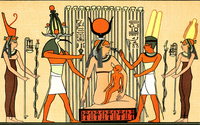 |
— UM.MA, ‘old woman’; Akkadian śibtu, where śibbu is “a mythical snake”, and śibirr
“shepherd staff, sceptre”, while ŚARA (the singer) contains the element ‘hook (?)’
from the previous ŚA-; the context must be the staff-tá, having moved to the North,
but originally Eden’s, the “singing” is like the spells use as ‘to re-create’, in the
many “singing-goddesses”; the ‘manicurist’ as related to the nails-fingers previously,
and “hairdresser” as in “keeping their new covering into place”; the term SIG can be
“to tie (together)” and “place”, Sig-kur-śaga then “(the place) to tie together the
mountain by the sceptre” as place of the staff-tá,
There was Dumuzid clothed in a magnificent garment and seated magnificently
on a throne. The demons seized him there by his thighs. The seven of them
poured the milk from his churns. The seven of them shook their heads like
……. They would not let the shepherd play the pipe and flute before her(?). She looked at him, it was the look of death. She spoke to him (?), it was
the speech of anger. She shouted at him (?), it was the shout of heavy guilt: “How much longer? Take him away.” Holy Inana gave Dumuzid the shepherd into
their hands. […] Dumuzid let out a wail and turned very pale. The lad raised his hands to heaven, to Utu: “Utu, you are my brother-in-law. I am your relation
by marriage. I brought butter to your mother’s house. I brought milk to Ningal’s
house. Turn my hands into snake’s hands and turn my feet into snake’s feet, so I
can escape my demons, let them not keep hold of me.”
— Dumuzid is a strange character: in another epic, “the dream of Dumuzid”,
his sister Geśtinanna is tortured by the gala-tura and kura-jara in section
above, to reveal where Dumuzid is hiding for them. Geśti-anna is “the heavenly
grapevine”, and should per context be the Watercourse, at the central pole,
who is indeed “tortured” by the both occupied arms of the lampstand (in the form
of both demons); GIŚ.TE, ‘part of a boat, cart or chariot” + ‘heaven’; also
in GIŚ.TI., the latter into a cluster with “tool, a tree, oriental plane tree,
staircase, ladder, to plow” and several others.
It makes Dumuzid almost automatically a candidate for the cherub — his
“garment” as eden’s masculine THA- is what they desire; that he is “seized by
his thighs” only supports the cherub theme; “milk” is used in the spells for
creating the realm-garment of sight (as in MAA-H’ESA), and compare the
‘churning the milky ocean’ in the Veda’s with the next line of “bringing
butter”.
Interesting is how this time Inanna is the one ‘speaking in anger’: the staff-tá
now directing the [stolen] word of the Watercourse, so powerful that even the cherub submits to it. In the epic “the return of Dumuzid”, he is sentenced to
stay half a year in heaven (kh-house) and half a year in the underworld; showing
how they use this bull cherub for their purposes. Finally – the sun as UTU
(śamaś) rescues Dumizid, by turning him into a gazelle [but remember how
sometimes events are being switched – since Utu is the result of the capturing
of the cherub], which is the new matrix rule over the head – compare the
vignette in Opening of Mouth pages, where the cut-off gazelle-head GEH’ES is
placed upon the line as new head; or the four gazelleheads in the Book of Gates,
at the top of the judgement hall of Osiris.
We wished to can read Sumerian the same well – but this will have to do, for
now; the important was the aim to read the symbolism in the texts, and we don’t
think we made a Stretch in interpreting them – it all appears very congruent.
For our use, we would need to find out whether the HEQ-glyph as shepherd staff
is a deformation from both the TERÁ- and NENNIU glyphs?
|
|
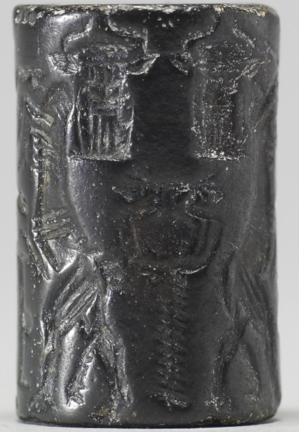 |
part VI: the Lyre above the Watercourse – Isaiah 16
1] https://www.funscience.in
2] for context of the enormous playout until this very moment (of God using souls to re-play all
the themes by souls, in order to win back all the lost aspects at the fall), it is important that Abraham
was starting out of the city of UR, having the name as the moongod Nannar
3] http://psd.museum.upenn.edu/nepsd-frame.html šamû
4] concerning BIL.GA, the name Bilha comes to mind – where in last dreampage
we went after the sons of Jacob, of which two sons were begotten by the maid
Bilha, we found an idea from someone who linked the name to Hurrian, as a
language closely linked to Akkadian. The same theme of ‘mixture’ appears in
the story of the twelve sons, of which four respresent the aspect of this page
5] see 2]
6] https://en.wikipedia.org/wiki/Epic_of_Gilgamesh
7] wiki; full text at etcsl.orinst.ox.ac dot uk/section1/tr1815.htm [broken link]
8] all quotes of the descent from https://etcsl.orinst.ox.ac dot uk/section1/tr141.htm [broken link]
9] inanna descent – kennethmarkhoover.files.wordpress.com

